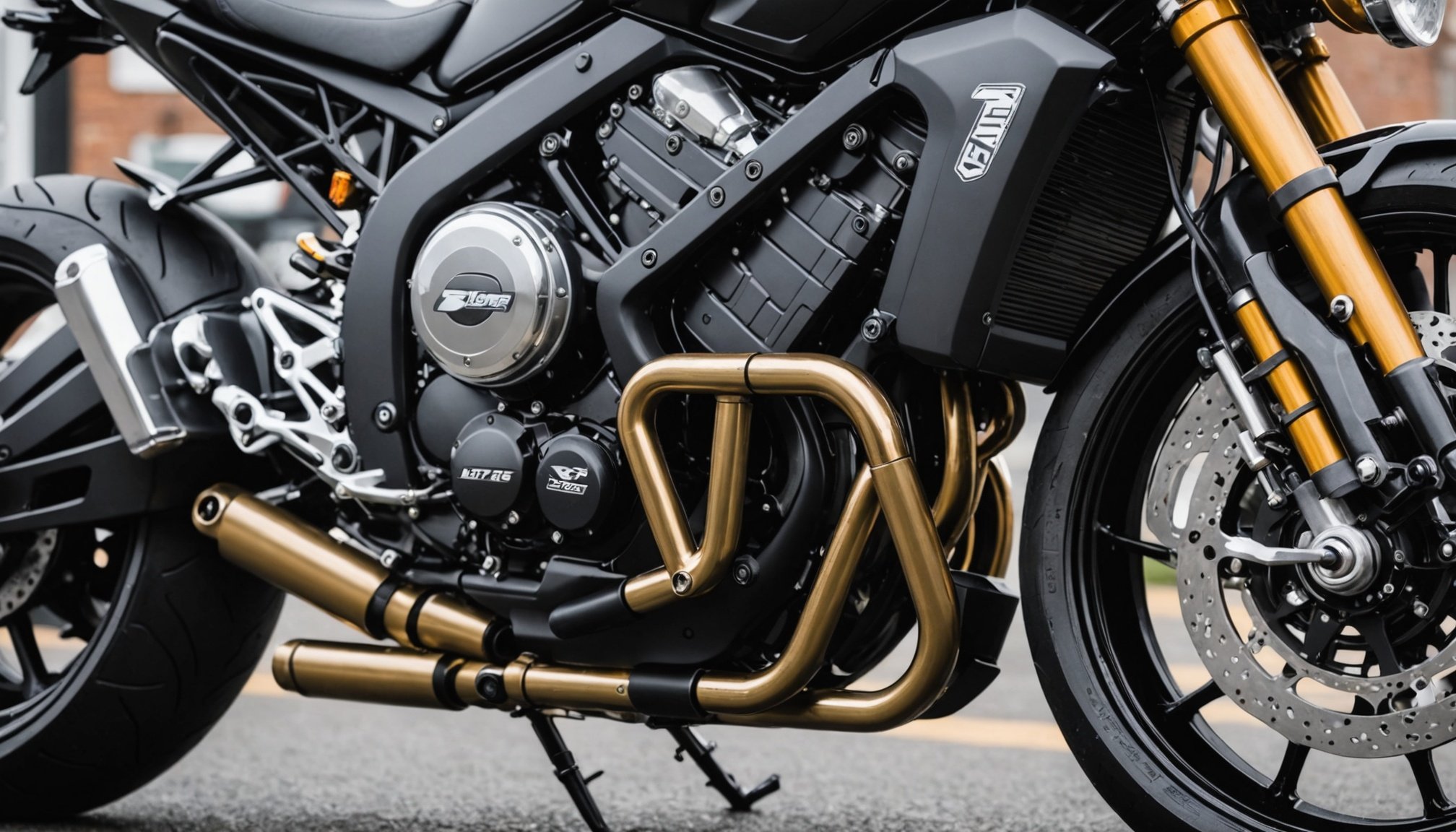Ultimate Guide to Selecting and Installing Aftermarket Frame Sliders on UK Sport Bikes
When it comes to enhancing the protection and performance of your sport bike, one of the most essential modifications you can make is the installation of aftermarket frame sliders. These components are designed to safeguard your motorcycle’s frame and other critical components in the event of a crash or slide, making them a must-have for serious riders. Here’s a comprehensive guide to help you select and install the right aftermarket frame sliders for your UK sport bike.
Understanding the Importance of Frame Sliders
Frame sliders are more than just an accessory; they are a crucial piece of protection for your motorcycle. Here’s why they are so important:
Also read : Ultimate Guide to Selecting Top Sport Bike Tires for Outstanding Mixed Terrain Adventures in the UK
- Protection Against Damage: In the event of a crash, frame sliders absorb the impact and distribute the force away from the bike’s frame, engine, and other vital components. This can significantly reduce the cost of repairs and prevent major damage[3].
- Enhanced Safety: By protecting the frame, sliders also help in maintaining the structural integrity of the bike, which is critical for rider safety.
- Peace of Mind: Knowing that your bike is better protected can give you the confidence to push your limits, whether you’re on the track or on the road.
Choosing the Right Frame Sliders
Selecting the right frame sliders involves several key considerations. Here are some factors to keep in mind:
Compatibility
Ensure that the frame sliders are specifically designed for your motorcycle model. Companies like Evotech Performance and R&G Racing offer sliders tailored to various bike models, such as the Kawasaki Z650 or the Honda CB650R[1][4].
Have you seen this : Top Winterizing Tips for Your UK Sport Bike Using a Battery Tender
Material Quality
High-quality materials are essential for effective protection. Look for sliders made from durable materials like stainless steel, aluminum, or high-density nylon. These materials can withstand significant impacts without compromising the bike’s frame.
Design and Fitment
The design of the slider should be such that it fits seamlessly with your bike’s aesthetics and does not interfere with other components like exhaust systems or engine guards. A well-designed slider will also be easy to install and maintain.
Customer Reviews and Feedback
Check customer reviews and feedback to get an idea of the product’s performance and ease of installation. For example, Evotech Performance is known for its high-quality parts and excellent customer service, as evident from numerous positive reviews[1].
Detailed Comparison of Popular Frame Slider Brands
Here is a comparison table of some popular frame slider brands to help you make an informed decision:
| Brand | Compatibility | Material | Design Features | Customer Feedback |
|---|---|---|---|---|
| Evotech Performance | Wide range of models including Yamaha MT-09, Honda CB650R, Kawasaki Z650 | High-quality stainless steel and aluminum | Easy installation, perfect fit, high-quality finish | Excellent customer service, easy to fit, high-quality products[1] |
| R&G Racing | Various models including Ducati, BMW, and Suzuki | Durable nylon and stainless steel | Aerodynamic design, quick release options | Highly recommended for protection, easy to install[4] |
| Other Brands | Model-specific | Varies (steel, aluminum, nylon) | Varies (some with quick release, others with integrated guards) | Mixed reviews, but generally positive for protection and durability |
Step-by-Step Installation Guide
Installing aftermarket frame sliders is a relatively straightforward process, but it does require some care and attention to detail. Here’s a step-by-step guide to help you through the installation:
Preparation
- Gather Tools and Parts: Ensure you have all the necessary tools and parts, including the frame sliders, mounting hardware, and any specific tools recommended by the manufacturer.
- Consult the Handbook: Read through the installation handbook provided by the manufacturer. For example, Evotech Performance often includes detailed instructions and videos to help with the installation[1].
Removing Existing Components
- Remove Fairings and Panels: You may need to remove certain fairings or panels to access the mounting points. Be careful not to damage any of these components.
- Disconnect Any Interfering Systems: If your bike has features like quick-release exhaust systems, you may need to disconnect these temporarily.
Mounting the Sliders
- Locate Mounting Points: Identify the correct mounting points on your bike’s frame. These are usually specified in the installation manual.
- Install Mounting Hardware: Install the mounting hardware such as bolts and spacers. Ensure these are tightened securely but do not overtighten.
- Fit the Sliders: Place the sliders over the mounting points and secure them using the provided hardware. Make sure they are aligned properly and do not interfere with any other components.
Final Check
- Reassemble Everything: Once the sliders are installed, reassemble any components you removed during the process.
- Check for Proper Fit: Ensure the sliders fit perfectly and do not rub against any other parts of the bike.
- Test the Installation: Take your bike for a short test ride to ensure everything is in place and functioning correctly.
Practical Insights and Actionable Advice
Here are some practical tips to keep in mind when selecting and installing aftermarket frame sliders:
Consult with Experts
If you are not comfortable with the installation process, consider consulting with a professional mechanic or a local bike shop that specializes in aftermarket modifications.
Use High-Quality Tools
Using high-quality tools can make the installation process much easier and reduce the risk of damaging your bike’s components.
Follow Manufacturer Instructions
Always follow the manufacturer’s instructions for installation. These instructions are designed to ensure the sliders are installed correctly and safely.
Real-Life Examples and Anecdotes
Many riders have benefited from installing aftermarket frame sliders. Here’s an example:
“I recently installed Evotech Performance frame sliders on my Yamaha MT-09. The installation was straightforward, and the quality of the parts was exceptional. During a minor slide, the sliders performed perfectly, protecting my bike’s frame and engine. It was a worthwhile investment for the peace of mind it gives me,” says John, a UK sport bike enthusiast.
Aftermarket frame sliders are an essential modification for any serious sport bike rider. By understanding the importance of these components, choosing the right brand and model, and following a detailed installation guide, you can significantly enhance your bike’s protection and your riding experience.
Here is a detailed bullet point list summarizing the key points to consider:
- Compatibility: Ensure the sliders are designed for your specific bike model.
- Material Quality: Look for high-quality materials like stainless steel, aluminum, or high-density nylon.
- Design and Fitment: Choose sliders that fit seamlessly with your bike’s aesthetics and do not interfere with other components.
- Customer Reviews: Check feedback from other riders to gauge the product’s performance and ease of installation.
- Step-by-Step Installation: Follow the manufacturer’s instructions carefully, and consider consulting a professional if needed.
- Final Check: Ensure all components are reassembled correctly and test the installation with a short ride.
With the right understanding and approach, installing aftermarket frame sliders can be a rewarding experience that enhances both the performance and protection of your sport bike.











